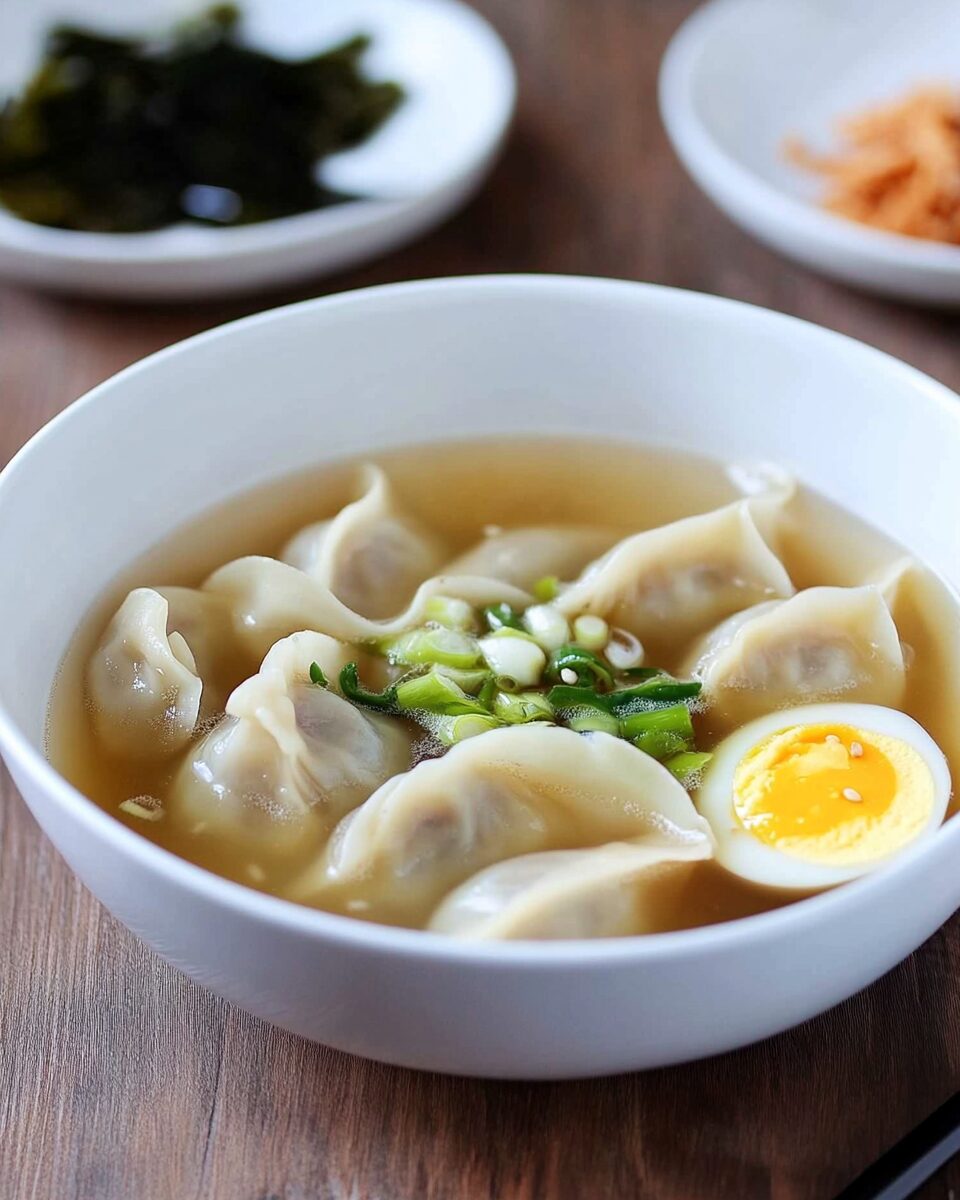The savory warmth of Manduguk, or Korean dumpling soup, offers a soothing escape into the heart of Korean cuisine. Made with soft dumplings, delicate egg ribbons, and chewy rice cakes floating in a rich, umami-packed broth, this dish is both satisfying and symbolic often enjoyed as part of the Korean New Year tradition for luck and longevity.
Whether you’re seeking comfort in a bowl or exploring a staple of Korean home cooking, Manduguk delivers a delicious balance of textures and flavors. It’s quick to make with store-bought dumplings or even better with homemade mandu. Perfect for cold weather or anytime you need a heartwarming meal, this recipe will become a beloved addition to your repertoire.
Full Recipe:
Ingredients:
-
12 Korean dumplings (mandu), homemade or store-bought
-
6 cups beef or anchovy broth
-
1 cup sliced Korean rice cakes (tteok)
-
2 eggs, beaten
-
1 scallion, finely chopped
-
1 garlic clove, minced
-
1 teaspoon sesame oil
-
Salt and pepper to taste
-
Optional: roasted seaweed strips (gim), julienned for garnish
Directions:
-
In a large pot, bring the broth to a boil over medium-high heat.
-
Add the sliced rice cakes and simmer for 5–7 minutes until softened.
-
Gently add the dumplings and cook for another 5–6 minutes or until they float and are heated through.
-
Stir in the minced garlic and season with salt and pepper to taste.
-
Slowly drizzle in the beaten eggs while stirring gently to create egg ribbons.
-
Finish with a few drops of sesame oil for aroma and flavor.
-
Ladle into bowls, garnish with chopped scallions and optional seaweed strips. Serve hot.
Prep Time: 10 minutes | Cooking Time: 15 minutes | Total Time: 25 minutes
Kcal: 310 kcal | Servings: 4 servings
The Comfort and Tradition of Manduguk (Korean Dumpling Soup)
Manduguk (만두국), or Korean dumpling soup, is a quintessential dish in Korean cuisine that captures the essence of comfort, warmth, and tradition. Often enjoyed during the cold winter months, especially on Seollal (Korean Lunar New Year), Manduguk symbolizes renewal and the beginning of a fresh year. The dish combines flavorful broth, delicate dumplings (mandu), soft egg ribbons, and chewy rice cakes (tteok), creating a harmonious blend of texture and taste.
This soup is more than just a warm meal; it is deeply embedded in Korea’s cultural identity and is often shared during family gatherings, celebrations, and significant milestones. The act of preparing and eating Manduguk carries emotional significance, making it a cherished recipe passed down through generations.
Cultural Significance of Manduguk
Manduguk plays an important role in Korean New Year celebrations. Traditionally, Koreans believe that eating a bowl of this soup on New Year’s Day allows one to “age a year,” signifying a symbolic rebirth and the hope for prosperity in the year ahead. The inclusion of rice cakes (tteok) is symbolic as well; their round, coin-like shape represents wealth and good fortune.
The mandu, or dumplings, represent luck and protection. When made by hand, families often involve everyone in the process, especially children, reinforcing bonds and familial love. Because of these associations, Manduguk is not just about nourishment but is a reminder of familial closeness and the importance of tradition.
Anatomy of the Dish
Manduguk is composed of several fundamental components that create a comforting and balanced soup. Each element contributes a unique texture and flavor to the overall experience.
-
Broth: Typically made from beef, anchovy, or kelp, the broth serves as the flavorful foundation. It’s rich, savory, and light enough to let the dumplings and other ingredients shine.
-
Mandu (Dumplings): These are filled with a mixture of minced meat (usually pork or beef), tofu, vegetables, and glass noodles. Mandu can be homemade or store-bought, with each version bringing its own character.
-
Tteok (Rice Cakes): Thinly sliced rice cakes provide a chewy texture and mild taste that complement the dumplings. These are traditionally used in another New Year dish called tteokguk, and their inclusion here blends both dishes into one.
-
Egg Ribbons: Lightly beaten eggs are gently poured into the hot soup, creating delicate ribbons that enhance both visual appeal and texture.
-
Garnishes: Common toppings include chopped scallions, crushed garlic, roasted seaweed strips (gim), and a drizzle of sesame oil for aroma and added flavor depth.
Each bite is a layered experience of chewy, soft, savory, and slightly nutty flavors a perfect representation of balanced Korean cuisine.
Homemade vs. Store-Bought Mandu
One of the beautiful things about Manduguk is its versatility. While making homemade mandu can be a labor of love that results in a more personalized and flavorful dish, store-bought dumplings also work perfectly for a quick and convenient meal.
Homemade mandu allow for creativity in the filling some prefer more meat, others prefer vegetarian options filled with kimchi and mushrooms. On the other hand, many high-quality frozen dumplings are now widely available and still produce a deeply satisfying Manduguk when time is short.
No matter which route you take, the soup remains a comforting, wholesome dish.
Nutritional Value and Benefits
Manduguk is not only delicious but also offers a balanced meal rich in proteins, carbohydrates, and healthy fats. The soup provides:
-
Protein from the meat-filled dumplings and eggs.
-
Complex carbohydrates from rice cakes, offering energy and a feeling of satiety.
-
Healthy fats when garnished with sesame oil.
-
Vitamins and minerals from ingredients like garlic, scallions, and seaweed.
It’s also easy to adapt for gluten-free or vegetarian diets, depending on the choice of dumpling fillings and broth base. This makes Manduguk a versatile and wholesome option suitable for a wide range of dietary needs.
When to Serve Manduguk
While Manduguk is traditionally served during Korean Lunar New Year, it is also a popular wintertime dish and a go-to comfort meal for days when something hearty and soothing is needed. It’s excellent for:
-
Weeknight dinners as a quick, nourishing soup.
-
Festive meals or Korean-themed dinner parties.
-
Recovery days when you need a light but fulfilling dish.
-
Family gatherings, especially during cold seasons.
Its simplicity, speed of preparation, and comfort factor make it an ideal addition to any home cook’s repertoire.
Pairings and Variations
Manduguk pairs beautifully with a variety of banchan (Korean side dishes) such as:
-
Kimchi (spicy fermented cabbage)
-
Pickled radish
-
Stir-fried anchovies
-
Japchae (glass noodles stir-fried with vegetables)
For those looking to vary the base or make it heartier, you can:
-
Add shredded beef brisket or tofu for added protein.
-
Use kimchi mandu for a spicy kick.
-
Replace rice cakes with noodles for a twist on the traditional version.
-
Create a vegetarian broth using kelp and shiitake mushrooms for a lighter, plant-based version.
The possibilities are endless, and Manduguk lends itself well to experimentation without compromising its comforting roots.
Cooking Tips for the Perfect Manduguk
Here are a few tips to ensure your Manduguk turns out delicious every time:
-
Don’t overcook the rice cakes – they become too soft if left in the broth too long.
-
Add the egg slowly and in a circular motion while stirring the broth gently to create beautiful egg ribbons.
-
Taste the broth before serving; a little bit of soy sauce, salt, or fish sauce can elevate the flavor dramatically.
-
Use freshly chopped scallions and seaweed strips just before serving for a burst of freshness and crunch.
Making the perfect Manduguk is a matter of balancing the timing and layering flavors thoughtfully.
Conclusion:
Manduguk is more than just a traditional Korean soup it’s a celebration of family, culture, and the simple pleasure of eating something warm and nurturing. Its historical significance during Korean Lunar New Year, its wholesome ingredients, and its comforting nature make it a timeless dish that transcends generations and borders.
Whether you’re exploring Korean cuisine for the first time or revisiting a beloved favorite, Manduguk offers a soul-satisfying experience that’s easy to make and even easier to enjoy. With its rich cultural story, balanced nutrition, and adaptable nature, Manduguk is a wonderful example of how food can nourish both body and spirit.

